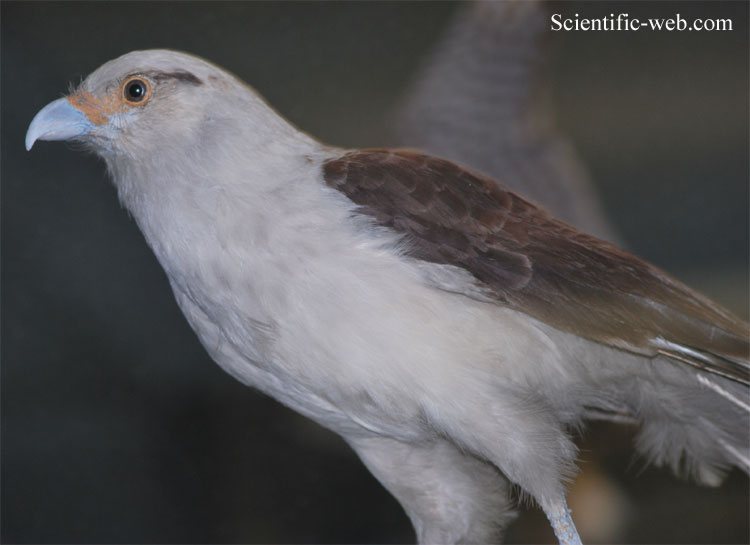Milvago chimachima , Photo: Michael Lahanas Cladus: Eukaryota Name Milvago chimachima (Vieillot, 1816) Reference Nouveau Dictionnaire d'Histoire Naturelle Appliquée Aux Arts, principalement à l'Agriculture et à l'Economie rurale et domestique par une société de naturalistes et d'agriculteurs, avec des figures tirées des trois règnes de la nature. 5 p.259 Vernacular names ---------- The Yellow-headed Caracara, Milvago chimachima, is a bird of prey in the family Falconidae. It is found in tropical and subtropical South America and the southern portion of Central America. Unlike the Falco falcons in the same family, the caracaras are not fast-flying aerial hunters, but are rather sluggish and often scavengers. The Yellow-headed Caracara is 41–46 cm (16–18 in) cm long and weighs 325 g (11.5 oz) on average. The female is larger than the male, weighing 310–360 g (11–13 oz), against his 280–330 g (9.9–12 oz). It is broad-winged and long-tailed, somewhat resembling a small Buteo. The adult has a buff head, with a black streak behind the eye, and buff underparts. The upperparts are brown with distinctive pale patches on the flight feathers of the wings, and the tail is barred cream and brown. The sexes are similar, but the head and underparts of immature birds have dense brown mottling. The voice of this species is a characteristic screamed schreee. This is a bird of savannah, swamps and forest edges. The Yellow-headed Caracara is a resident bird from Costa Rica south through Trinidad and Tobago to northern Argentina (the provinces of Misiones, Chaco, Formosa, Corrientes and Santa Fe). It is typically found from sea level to 1,800 m (5,900 ft), occasionally to 2,600 m (8,500 ft) ASL. In southern South America, it is replaced by a close relative, the Chimango Caracara (Milvago chimango), whose range overlaps with that of the Yellow-headed Caracara in southern Brazil, northern Argentina, Paraguay and Uruguay. A larger and stouter paleosubspecies, Milvago chimachima readei, occurred in Florida and possibly elsewhere during the Late Pleistocene, some tens of thousand years ago.[1] According to the Peregrine Fund database, the Yellow-headed Caracara is expanding its range into Nicaragua.[2] The Yellow-headed Caracara is omnivorous, and will eat reptiles, amphibians and other small animals as well as carrion. Birds are rarely if ever taken, and this species will not elicit warning calls from mixed-species feeding flocks that cross its path even in open cerrado habitat .[3] It will also take ticks from cattle, and is locally called "tickbird". In addition, at least younger birds are fond of certain fruits, such as those of the Oil palm (Elaeis guineensis) and Pequi (Caryocar brasiliense).[4] It lays from five to seven brown-marked buff eggs in a stick nest in a tree.[5] The Yellow-headed Caracara has benefited from forest clearing for cattle ranching. Its status in Trinidad has changed from rare to fairly common, and it was first seen on Tobago in 1987.[6] It adapts readily to urban areas and, together with species such as the American Black Vulture (Coragyps atratus), it is among the most commonly seen bird of prey in Latin American cities. Consequently, this wide-ranging species is not considered threatened by the IUCN.[7] In Panama City for example, as a result of the increased urban sprawl, Yellow-headed Caracara pairs are frequently seen along the rooftops in suburban neighborhoods. Footnotes 1. ^ Emslie, Steven D. (1998). "Avian Community, Climate, and Sea-Level Changes in the Plio-Pleistocene of the Florida Peninsula". Ornithological Monographs (American Ornithologists' Union) 50: 44–45. http://elibrary.unm.edu/sora/om/om050.pdf.
* BirdLife International (BLI) (2008). Milvago chimachima. In: IUCN 2008. IUCN Red List of Threatened Species. Downloaded on 19 November 2008. Source: Wikispecies, Wikipedia: All text is available under the terms of the GNU Free Documentation License |
|

